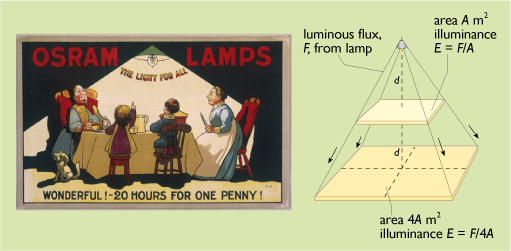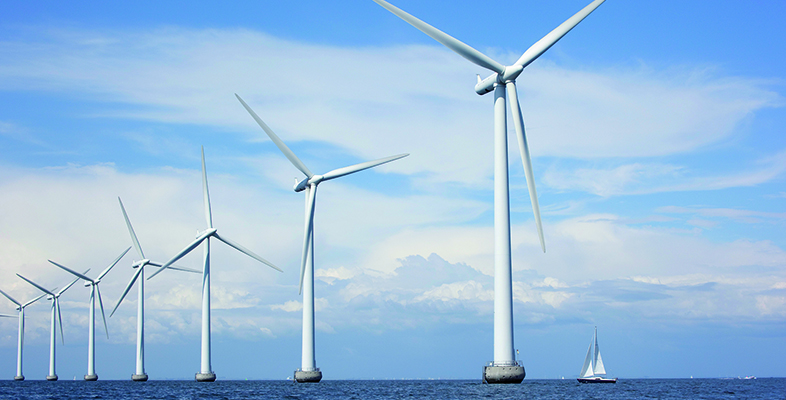4.2.3 Lighting and illuminance
Efficient lighting isn’t just about using high-efficacy lamps. It is also about properly illuminating the things that we want to see, such as a book. LED lamps have an advantage over traditional lamps in that they are directional, the light only emerges from one side of the semiconductor chip. This is one reason that they have been so successful when used in torches.
A typical incandescent light bulb emits light in all directions. We talk of this ‘flow’ of light as the luminous flux emitted by the lamp. When a lamp is mounted in a ‘light fitting’ or luminaire, the flow of luminous flux will be concentrated in one particular direction (e.g. downwards in the case of a normal ceiling luminaire). A certain number of lumens are therefore concentrated in a particular direction.
When we come to the practical aspects of ‘seeing what we are doing’ we need to know about the amount of light falling on a given surface. This is known as the illuminance and has the SI unit, the lux. One lux is defined as a luminous flux of 1 lumen falling on an area of 1 m2.
For example, the diners (circa 1910) in Figure 43(a) may be enjoying their electric light. They are also being energy-efficient. Hanging the bulb close over the table may have been necessary, not just because of the low efficacy of incandescent lamps, but also because they were probably paying, in real terms, about four times more than today’s price for electricity.

Are they likely to be getting an adequate illuminance on their table? The energy radiated by the lamp spreads out over a larger area as the distance from the lamp increases (Figure 43(b)). Suppose that the table, with an area A square metres, receives the full beam when the lamp is at a distance d from it. If the lamp was at a distance 2d, the beam would spread over four times the original area. At this distance the table would only receive a quarter of the full beam. In other words, doubling the distance has reduced the illuminance by a factor of four.
This inverse square law applies to any simple light source (except where the beam is focused by lenses or mirrors).
If we assume in Figure 43(b) that the lamp is rated at 40 watts and has an efficacy of 5 lm W–1 (a typical figure for 1910), then it will be producing 200 lumens. The luminaire (the lampshade) may be only 75% efficient, so a total of only 150 lumens will be projected downwards. If we assume that half of this, 75 lumens, actually shines on the table, and that this has an area of 1 m2, then the illuminance is 75 lm m–2 or lux.
Artificial lighting schemes are usually specified as being capable of supplying a specified number of lux on a horizontal surface – the ‘working plane’. Generally the more demanding the work, the higher the required level of illuminance. Table 13 gives some recommended values.
| Task | Recommended illuminance /lux |
|---|---|
| Circulation areas (stairs, corridors) | 150 |
| Classroom desk | 300 |
| Office desk, laboratory bench | 500 |
| Electronics assembly | 1000 |
| Hospital operating theatre | 2000 |
The danger of a list like this is that it can be taken as a specification for a whole building and result in permanently overlit spaces in shops and offices. This is one reason why the services sector uses so much electricity for lighting.
A more energy efficient approach is to employ ‘task lighting’ – individual controllable lighting where it is actually needed. This is where the directional properties of LEDs give them a significant advantage. Although white LEDs may produce fewer lumens per watt than a sodium street lamp, they can direct that light more efficiently to where it is actually needed.
Also, the best use should be made of daylight. Sunlight is extremely bright and its illuminance can reach 100 000 lux on the ground. However as a light source it suffers from rapid fluctuations caused by passing clouds. Under overcast sky conditions normal daylight has an illuminance of at least 5000 lux and is more constant. Daylight penetrating windows into a building can provide illuminance levels of around 200–300 lux in typical naturally lit offices for most of the day. The difficulty is in persuading occupants to turn off the artificial lights.
Activity 16
Calculate the new illuminance level (in lux) on the dinner table of Figure 43(a) in each of the following cases:
- a.the lamp power remains the same but its efficacy is doubled to 10 lumens W−1.
- b.the lamp is unchanged but its distance from the table is halved.
Answer
- a.If the efficacy of the lamp is doubled, then it will produce 400 lumens instead of only 200 and the illuminance on the table will also double from 75 lux to 150 lux.
- b.If the distance between the lamp and the table is halved, then the illuminance on the table will increase by a factor of four, from 75 lux to 300 lux (i.e. adequate for a ‘classroom desk’ in Table 13.
Activity 17
Why did some nineteenth century hospitals site their operating theatres on the top floor of the building?
Answer
Table 13 recommends that an illuminance of 2000 lux should be used in operating theatres. Before the advent of modern high-intensity electric light, the only way to get this was to perform operations in bright daylight.
